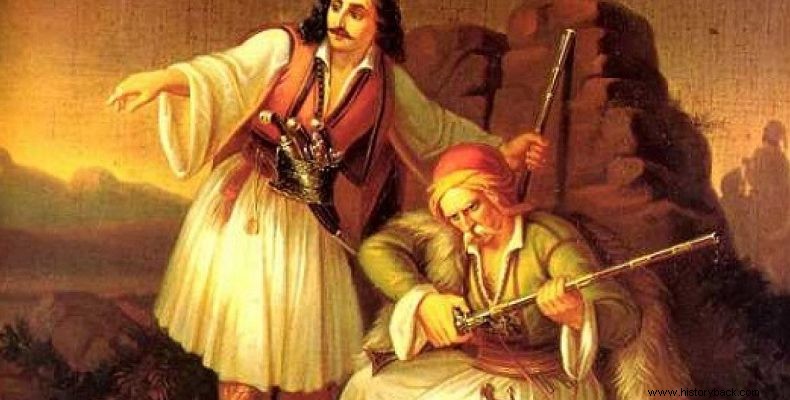
There are certain figures in history that, like passing stars, light up and disappear, but leave behind vivid memory. Katsantonis was such a figure. Antonis Makrygiannis was born in the village of Marathos of Agrafon. Some say, however, that he was born in Vastavetsi, Epirus. Sources do not agree on his date of birth either. The prevailing opinion states that he was born in 1775.
Ioannis's father was a tseligas. He married the daughter of captain Dipla Areti and had four children, Antonis, Kostas (who was called Lepeniotis because he was born in Lepenou of Xiromeros), George (who was called Hasiotis because he was born in Hasia), Christos known as "kutsiko" (small ) and Katerina.
Thief
Antonis, following in his father's footsteps, engaged in animal breeding. Some sources state that he married and had a son. But this is not confirmed. How Antonis turned from Tseligopoulos into Katsantonis, feared by Turks and Albanians, is not completely ascertained.
The prevailing theory wants him to kill a Turk who tortured him accusing him of animal theft. Other sources report that he was arrested along with his father on the same charge. No matter how short and sickly Antonis was, around 1800 or more likely in 1802 he had gone to the mountain and joined the thief corps of his grandfather Captain Dipla. His brothers went out to the mountain with him.
The infamous Ali Pasha of Ioannina in response arrested and killed his parents, burned their house and seized their property. Regarding its renaming to Katsantoni, the versions also vary. One of them mentions that his mother, trying to prevent him from going up the mountain, shouted "Sit down, Antony". Others say that Katsa comes from the Turkish "katsan" which means fugitive.
Battles
In 1803, Ali sent Iliasbeis against him with 300 Turkalvans. But Katsantonis defeated them and killed their leader himself. In the same year, he defeated an even stronger Turkish force in Kerasovo. In 1804 in Kehrinia, near Katouna of Xiromeros, he disinterred the body of Koutzou Mustafa Bey. Of the 150 Turkalvans, 145 were killed and the others captured, but Katsantonis spared their lives.
Ali, unable to defeat him, tried to join forces with Katsantonis, but did not succeed. Later, however, he became a charioteer of the Agrafos for a time. Many more battles followed. In August 1806 he defeated the corps of Turkalvan Alous Beratis with a force of 400 men. In October 1806, however, he was seriously injured in a battle with the Turkalvans of Bekir Jogadourou and had to be transferred to Lefkada for recovery. He stayed there for three months and came into contact with the Greek in Russian service Papadopoulos with the aim of inciting Genos.
Later he went again to Lefkada and participated in the "assembly of the Kleftarmatoli" called by Ioannis Kapodistrias with the aim of a general revolution against the Turks. In Lefkada he also met Theodoros Kolokotronis.
However, on his way to Lefkada, the Turkalvans were waiting for him at the bridge of Manolis in Tatarna, Evrytania. There a fierce battle took place. However, the 1,500 Turkalvans could not defeat the approximately 300 Greeks of Katsantonis and Kitsos Botsaris. Katsantoni's grandfather Captain Diplas was also killed in this battle fighting with sword in hand.
Returning he continued his action. In 1807 he fought a great battle with 1,000 Turkalvans, under Agos Mouhurdaris. Over 150 enemies were killed against 12 Greeks. In 1808 he achieved another victory against Hasan Belousi. 40 Turkalvans and only one Greek fell in the battle.
In the same year, in Prosiliakos, the corps of Katsantonis, in which Karaiskakis had joined, fought the infamous Velis Gekas, the first lieutenant of Ali, who was killed in the battle. Veli Gekas had promised Ali to bring him the head of Katsantonis to Ioannina...
Disease, arrest, torture
What the Turks couldn't do, however, the smallpox did. The ailing body of Katsantonis could not withstand so many hardships and the heroic thief became seriously ill. So he retired with his brother George and five other lads to a cave. But there he was betrayed.
Again there are various versions as to who or what betrayed him. Other sources speak of a shepherd who was cruelly tortured to reveal the cave, others of an old beggar woman, others of a monk or priest who was also tortured, or some children.
In any case, the Turks surrounded the cave and after a short battle in which four (some say five) men of Katsantonis were killed and his brother wounded, they captured the legend of theft alive.
In Ioannina, Ali decided to kill the two brothers by breaking the bones. Under the great plane tree, the bones of the two Greeks, who according to tradition bravely endured the torture, were broken.
The French consul at the court of Ali Pouqueville mentions his nephew Veli Geka as the torturer of Katsantonis. Although there are different versions, it seems that the two thieves encouraged each other to endure without "women's cries and moans".
"Two gypsies tied him to the anvil and began to chip him with a hammer. Alders throw the bones, scatter the marrows, nerves, cut meat, crawl like leaves and this one holds the sky and sweetly sings:You hit, you chip with dogs, Katsantonis is not afraid of Alipasas, fire, hammer and anvil", he wrote about their martyrdom , demonstrably, the great Aristotle Valaoritis.
This is how Katsantonis, small in stature and physique, but big in boyhood, was lost, leaving behind a brilliant example of courage and cheerfulness.

Katsantonis. Wax figure from the Vrelli museum in Ioannina.

Typical depiction of a Greek klephtarmatolo.
